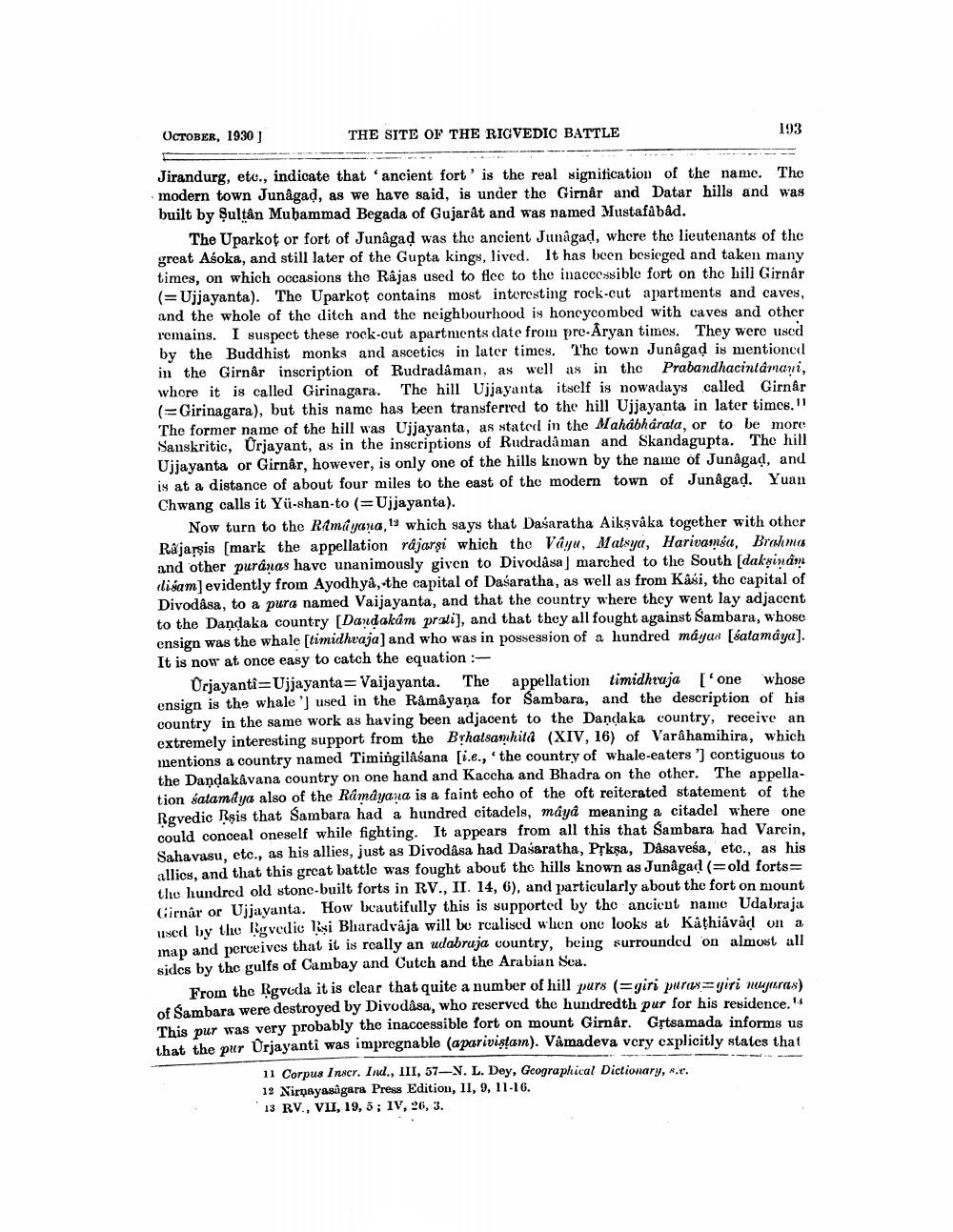________________
OCTOBER, 1930)
THE SITE OF THE RIGVEDIC BATTLE
193
Jirandurg, etc., indicate that 'ancient fort' is the real wignitication of the name. The modern town Junagad, as we have said, is under the Girnår and Datar hills and was built by Sultan Muhammad Begada of Gujarat and was named Mustafâbâd.
The Uparkot or fort of Junagad was the ancient Junagad, where the lieutenants of the great Asoka, and still later of the Gupta kings, lived. It has been besieged and taken many times, on which occasions the Râjas used to flee to the inaccessible fort on the hill Girnår (=Ujjayanta). The Uparkot contains most interesting rock-cut apartments and caves, and the whole of the ditch and the neighbourhood is honeycombed with caves and other remains. I suspect these rock-cut apartments date from pre-Aryan times. They were used by the Buddhist monks and ascetics in later times. The town Junagad is mentioned in the Girnår inscription of Rudradaman, as well as in the Prabandhacintamani, where it is called Girinagara. The hill Ujjayanta itself is nowadays called Girnar (=Girinagara), but this name has been transferred to the hill Ujjayanta in later times." The former name of the hill was Ujjayanta, as stated in the Mahabharata, or to be more Sanskritic, Orjayant, as in the inscriptions of Rudradaman and Skandagupta. The hill Ujjayanta or Girnar, however, is only one of the hills known by the name of Junagad, and is at a distance of about four miles to the east of the modern town of Junagad. Yuan Chwang calls it Yü-shan-to (=Ujjayanta).
Now turn to the Ramayana, 13 which says that Dasaratha Aikşvâka together with other Rajarsis (mark the appellation räjarşi which the Vayu, Malnya, Harivamsa, Brahima and other puranas have unanimously given to Divodâ sa marched to the South [daksinam lisamevidently from Ayodhyâ, the capital of Dasaratha, as well as from Kaši, the capital of Divodása, to a pura named Vaijayanta, and that the country where they went lay adjacent to the Dandaka country [Dandakam prati], and that they all fought against Sambara, whose ensign was the whale [timidhuaja) and who was in possession of a hundred mayas (satamaya). It is now at once easy to catch the equation :
Orjayanti=Ujjayanta= Vaijayanta. The appellation timidhruja ['one whose onsign is the whale') used in the Ramayana for Sambara, and the description of his country in the same work as having been adjacent to the Dandaka country, receive an extremely interesting support from the Byhatsanhita (XIV, 16) of Varahamihira, which mentions a country named Timingilâśana [i.e., 'the country of whale-eaters ') cortiguous to the Dandakâvana country on one hand and Kaccha and Bhadra on the other. The appellation satamtya also of the Ramayana is a faint echo of the oft reiterated statement of the Rgvedic Rşis that Sambara had a hundred citadels, máyd meaning a citadel where one could conceal oneself while fighting. It appears from all this that Sambara had Varcin, Sahavasu, etc., as his allies, just as Divodása had Daśaratha, Přkşa, Dåsaveśa, etc., as his allics, and that this great battle was fought about the hills known as Junagad (=old forts= the hundred old stone-built forts in RV., II. 14, 6), and particularly about the fort on mount Girnar or Ujjayanta. How beautifully this is supported by the ancient name Udabraja used by the Ryvedic Isi Bharadvaja will be realised when one looks at Kathiávåd on a nad and perceives that it is really an udabruja country, being surrounded on almost all sides by the gulfs of Cambay and Cutch and the Arabian Sea.
From the Rgveda it is clear that quite a number of hill purs (=giri purax=yiri numaras) of Sambara were destroyed by Divodása, who reserved the hundredth pur for his residence. This pur was very probably the inaccessible fort on mount Girnar. Gytsamada informs us that the pur Orjayanti was impregnable (aparivistarn). Vâmadeva very explicitly states that
11 Corpus Inscr. Ind., III, 57-N. L. Dey, Geographical Dictionary, .t. 12 Nirnayasagara Press Edition, II, 9, 11-16. 13 RV., VII, 19, 5; IV, 26, 3.




